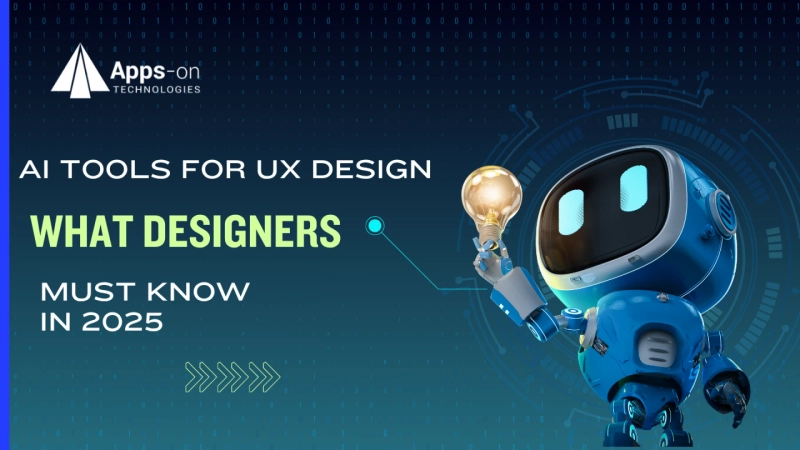The rapid evolution of artificial intelligence (AI) has transformed nearly every industry — and UX design is no exception. As we move through 2025, AI tools are not only making user experiences smarter and more intuitive but also streamlining the design process itself. From intelligent prototyping to predictive user behavior modeling, designers today must understand how AI is shaping the future of their work.
For companies investing in AI and ML consulting, the integration of AI into UX isn't just about technology — it’s about creating interfaces that truly understand and adapt to user needs. In this blog, we'll explore the top AI tools for UX design, how they are being used, and what every designer should know to stay competitive in 2025.
Why AI Matters in UX Design
UX design is about understanding users — their goals, behaviors, frustrations, and preferences. AI complements this by adding data-driven insights and automation to the creative process. Instead of relying solely on human intuition or user testing, AI offers:
- Behavior prediction based on past user interactions
- Personalized user journeys powered by machine learning algorithms
- Automation of repetitive design tasks, freeing time for creative problem-solving
- Accessibility enhancements through natural language processing and image recognition
By harnessing AI, designers can deliver richer, faster, and more responsive experiences.
Top AI Tools Transforming UX in 2025
1. Uizard – AI-Powered Design From Sketch to Screen
Uizard is an intuitive AI tool that allows designers to convert hand-drawn wireframes or rough sketches into digital, interactive prototypes. Ideal for rapid prototyping, it reduces time spent on translating ideas into usable formats.
2. Khroma – Smart Color Palette Generator
Powered by machine learning, Khroma learns your preferences and helps generate custom color palettes suited for branding and UX design. This tool is especially useful in maintaining visual consistency.
3. Figma AI – Smarter Collaborative Design
Figma, already a favorite among UX designers, has integrated AI features like auto-layout suggestions, real-time design feedback, and AI-generated design elements. It also enables quick iterations, predicting user flow and UI interactions.
4. Runway ML – Creative AI for Design and Interaction
Runway ML allows designers to experiment with generative design, voice interfaces, and computer vision. From auto-editing user feedback videos to generating images from text prompts, it is a valuable tool for UI/UX storytelling.
How AI Enhances the UX Workflow
AI doesn't just support UX tools — it transforms the workflow:
User Research and Data Analysis
Tools like Google’s AutoML and IBM Watson allow UX teams to analyze large amounts of user behavior data, extracting trends and suggesting improvements. These platforms, commonly used in ai business consulting, reduce the need for manual data crunching.
Predictive Design
AI can predict how users might navigate an app or site, suggesting layout changes or interaction models before A/B testing even begins.
Automated Design Assistance
AI assistants can now recommend UX writing, optimize design layouts for better usability, and even simulate user flows to detect bottlenecks — all without extensive human input.
Benefits of AI Tools in UX Design
The advantages of integrating AI tools into UX design include:
- Speed: Faster wireframing, prototyping, and testing
- Precision: Data-backed design decisions minimize guesswork
- Scalability: Design systems can be adapted and personalized for diverse audiences
- User-Centricity: AI keeps user behavior at the center, even at scale
These benefits are driving more startups and enterprises to collaborate with an AI consulting business that can guide design teams through strategic AI adoption.
Use Cases: AI in Action for UX Designers
Case Study 1: E-commerce Personalization
An online clothing retailer implemented an AI-driven recommendation system into its UX. Using purchase and browsing history, AI generated personalized homepages, improving conversion rates by 35%.
Case Study 2: Chatbot Optimization
A financial services company enhanced its chatbot’s UI/UX using AI to analyze user queries. The improved conversational flow led to higher customer satisfaction and reduced support ticket volume.
Case Study 3: Accessibility for All
A healthcare app utilized AI to make its platform more accessible to users with disabilities. Using computer vision and speech synthesis, the app adapted its interface in real time based on the user’s interaction style.
Challenges Designers Must Overcome
While the benefits are immense, integrating AI into UX design isn't without challenges:
- Ethical Concerns: Personalization should not compromise user privacy.
- Over-Reliance on Data: Design intuition still plays a critical role.
- Learning Curve: Not all designers are well-versed in AI technologies.
To tackle these challenges, designers can collaborate with an AI development company in the USA to build responsible and effective AI-driven design solutions.
Future Outlook: AI + UX = Human-Centered Innovation
As AI matures, UX will become even more user-centric. Designers will spend less time on repetitive tasks and more time on creative exploration and problem-solving. The synergy between human creativity and AI precision is unlocking a new era in design.
In 2025 and beyond, those who embrace AI tools in UX will not only stay competitive but also lead the way in creating more inclusive, intelligent, and efficient digital experiences. Partnering with experts in AI Consulting Business can give design teams the technological edge they need to thrive.
Conclusion
AI is not replacing UX designers — it is empowering them. The integration of AI tools into UX workflows enhances everything from research to prototyping to personalization. Designers who want to stay ahead must familiarize themselves with these tools and understand how AI is reshaping the user experience landscape.
Whether you’re working solo or within an enterprise, consider collaborating with an AI development company in the USA to help implement the right AI tools for your needs. In 2025, design innovation belongs to those who leverage the full power of artificial intelligence. Visit my company Website at appsontechnologies.com/
Original Source: https://bit.ly/3FKRxig


